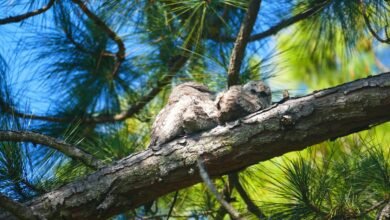Yariabini, overlooking the waters of the Nymabaga,
the sacred mountain floats over cloud – women’s dreaming,
Koala Dreaming. I think of Shangri-La, but Dreaming is here
-now-then, in-on-of Country, not distant, not imagined.
Large flocks of white birds spin across the river, Crested
Terns, some Little Terns, one way then the other, more
stand on the lip, all rise as a Brahminy Kite circles over
and call out rough barking before settling back down.
Pied Oystercatchers forage both banks, fledgling Peewees
wait on a branch, the ones we saw gaping in the nest
a week ago, the nest we saw being built, methodically
and quickly by both parents, using mud from our lives.
Photographs cannot remember this, not everything,
the landscape, the simmering ocean, the pulse,
catching a dolphin arching, the humidity, sweating
under my cap, holding your hand, so quiet so early.
From the base of a Crinum Lily, fledgling Fairy-wrens
are begging for breakfast. The dolphin cruises upriver
then changes its mind. There’s no need for Shangri-La,
this world is enough. So why are we dismantling it?
Notes:
Yarriabini in Gumbaynggir also known as Dunggirr julum (Koala Mountain) is called Yarri yapani in Dhanggati. Yarriabini means ‘Koala rolling down the mountain’ The late Gumbaynggirr Elder, Uncle Mark Flanders, says, ‘The mountain at Yarriabini is believed to be a koala Dreaming site. Two giant koalas had a fight there and went rolling down the mountain.’ I also heard that the Dunggirr Gagu (the Koala Brothers) fought Tiger Cat to save the people and a boomerang cut one of the brother’s head off, and its body forms the three peaks.
Government surveyor Clement Hodgkinson was one of the first non-convict Europeans to explore here and he climbed the mountain. In his book, From Port Macquarie to Moreton Bay (1845), he describes an eleaborate ‘Cawarra’ initiation ceremony of the Yarriabini tribal group and noted: ‘The surrounding trees are minutely tattooed and carved to such a considerable altitude, that one cannot help feeling astonished at the labour bestowed upon this work.’[i]
In 1978 anthropologist, K.H. Lane investigated Aboriginal carved trees along the Nyambaga (Nambucca River), and found a few sacred carved the last left in situ on the North coast. Twenty-five years later, in 2006, the sacred Gunya tree at Bellwood was destroyed by fire, in an area marked for development. An archaeological report of the area in 2002 had found, ‘A scarred tree exhibiting steel-axe cut marks was recorded in the north-western corner of the survey area, and was interpreted as having been deliberately made in removing a strip of bark for the construction of a gunyah or temporary shelter. No other archaeological or cultural remains were recorded.’ [ii] The report recognised the cultural significance of the place where the scarred tree had been, and recommended that, ‘by way of respect to the cultural association of the place the reserve should be named by the Aboriginal community, as for example, ‘Gunyah Tree Reserve’ or something of the Aboriginal community’s choosing.’
No koalas have been seen on the mountain for over thirty years and no sacred trees remain. Pied Oystercatchers are listed as Endangered in NSW. So much has been and is being lost.
Shangri-La
Tibetan scriptures mention the existence of seven utopias, the Nghe-Beyul Khembalung. They are earthly paradises isolated from the world, not unlike Shangri-La, the fictional valley in Tibet portrayed in the 1933 novel ‘Lost Horizon’ by James Hilton. He said he used the travelogue of two French priests, Evariste Regis Huc and Joseph Gabet (1844–1846), to provide the background to Shangri-La. Shangri-La is a mystical valley in Tibet where people lived happily for hundreds of years, but a few years earier Hilton had visited the Hunza Valley, near Gilgit in Pakistan. ‘Being an isolated green valley surrounded by mountains, enclosed on the western end of the Himalayas, it closely matches the description in the novel; although in a reversal on the story, due to increased exposure to ultraviolet radiation, inhabitants of the high-altitude parts of the valley appear to age quickly.’ (Wicki)
Nearly twenty years ago, Pico Iyer wrote, ‘When you touch down in Tibet, the land that inspired Shangri-La, you are greeted by an unattractive ‘Airport Hotel,’ by a whole makeshift community built in the middle of the otherwise deserted plateau, and by large numbers of other Americans—and Japanese and Germans—who’ve come here to get a break from Americans or Japanese or Germans. Whole airplane economies grow up that seem to unsettle the rhythms of communities that had remained unchanged for centuries (until well into the 20th century, Tibet had not even seen wheeled transport).’ [iii]
Things change quickly now. In June 2021, a rail line connected the Tibetan capital Lhasa with the city of Nyingchi. ‘Traveling at high altitudes, the Fuxing trains are equipped with automated oxygen supply systems, which keep oxygen levels at a constant 23.6% — slightly higher than the 21% average found in normal atmospheres. The trains’ windows are equipped with a special layer of glass designed to withstand the region’s high UV levels.’ [iv]
[i] See Susan Coumbe, Thesis: ‘Footprints in the Forest: A visual exploration of the tall timber forests of Northern New South Wales’, University of Newcastle, 2009, p35-6.
[ii] John Appleton, Archaeological Surveys & Reports PTY LTD, Project No. 446/09, Dec 2009 For Geoff Smyth Consulting on behalf of Nambucca Gardens Estate, https://nambucca.nsw.gov.au/cp_content/resources/Archaeological_Assessment.pdf
[iii] Pico Iyer, ‘The Magic of Flight’, Via, November 2003. http://www.viamagazine.com/top_stories/articles/flight03.asp
[iv] Maggie Hiufu Wong, ‘Tibet’s first bullet train line enters service’, CNN, 12 July 2021.










